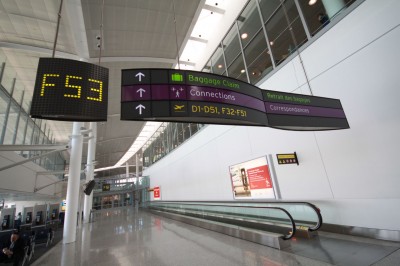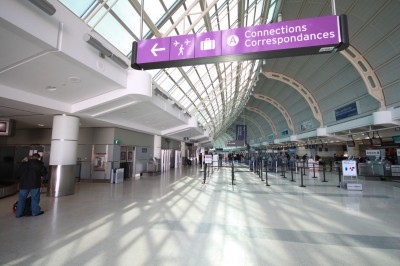By Peter Saunders
At the end of January 2012, Toronto Pearson International Airport went ‘zonal,’ implementing a new, uniform alphanumeric system for naming all flight gate lounges throughout Terminals 1 and 3 (T1 and T3). While it was important early on to educate airport employees about the change internally, the renumbering project also entailed the need to retrofit and replace corresponding signs facing airline passengers in both terminals.
The Greater Toronto Airports Authority (GTAA), which manages Toronto Pearson, began the rezoning process in an effort to improve wayfinding in both terminals, especially for passengers with connecting flights.
“The old system used flags and words to indicate where to go for connections, but it became confusing if you were, for example, flying through Canada and the U.S. to a destination in South America,” explains Peter Wiszniewski, GTAA’s signage project manager. “We needed to make it easier for passengers to find their way. And most international airports around the world are already zone-oriented.”
Following purple
Inspired by London Heathrow Airport in England, for example, GTAA added a new purple colour to its signs. This motif became a handy way to direct passengers to new connection centres that can better facilitate their transfers.
“Our connections prompted this change,” says Wiszniewski. “Out of 33.4 million passengers per year, about 26 per cent are now making connections. It’s a lot easier to tell them to follow the purple signs to reach their flights. The colour really stands out.”
GTAA’s operations team studied eight shades and worked with Canadian National Institute for the Blind (CNIB) standards to determine which option would be most clearly visible.
The connection centres, meanwhile, were developed to offer gate information to passengers hurrying to make their transfer flights. These new structures reuse existing signs and indicate estimated walking times to each zone—or in the case of transfers between terminals, combined walking and shuttle train time.
“The premise behind this flow is when passengers arrive, they walk up to the connection centres to find their next gate letter and number,” says Wiszniewski. “They work hand in hand with the signs.”
In another similarity to other airports’ past rezoning experiences, Pearson’s gate name changes only affect interior signage, not the airside gate numbers, which remain the same as before.

The new connection centres are designed to help passengers transfer flights more quickly. In addition to gate information, they indicate estimated walking times to each zone.
“The two systems aren’t dependent on each other,” Wiszniewski explains.
Meanwhile, new ceiling-mounted Flight Information Display Systems (FIDSs) switched from 1-m (42-in.) to 1.4-m (55-in.) screens to accommodate more details, including an additional column for each flight’s zone letter. In general, however, GTAA used the opportunity to eliminate unnecessary information to simplify its many directories and maps.
Letters and numbers
The new alphanumeric system, somewhat similar to one that was already in place in T3, combines gate numbers with sector-specific letters.
In T1, this means adding D for domestic, E for international and F for U.S. flight gates, while also maintaining the standard three-digit format. In T3, the revised system comprises zone A for U.S. flights, zone B for a combination of U.S., domestic and international flights and zone C for remaining domestic and international flights.
“We tried to keep the gates similar to before, so Gate 132 becomes Gate D32, for example,” says Wiszniewski. “Some ‘swing gates’ are used for both domestic and U.S. flights, however, so we have added dynamic illuminated signs in T1 that change when their doors switch, while in T3 these signs are still changed over manually. I believe the new alphanumeric naming of the swing gates makes them a little easier to use.”







